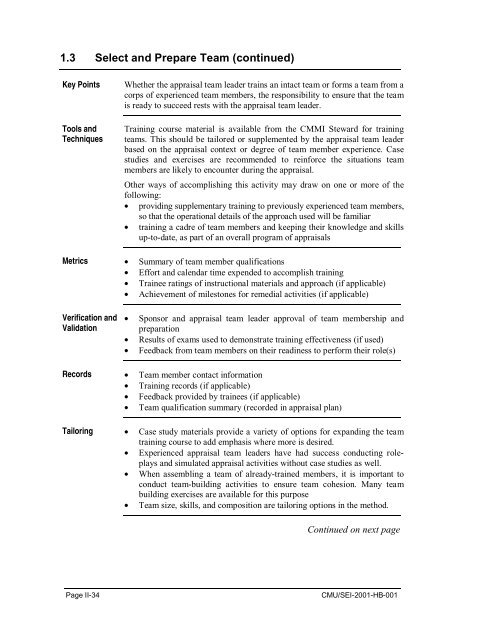Standard CMMI Appraisal Method for Process Improvement (SCAMPI)
Standard CMMI Appraisal Method for Process Improvement (SCAMPI)
Standard CMMI Appraisal Method for Process Improvement (SCAMPI)
You also want an ePaper? Increase the reach of your titles
YUMPU automatically turns print PDFs into web optimized ePapers that Google loves.
1.3 Select and Prepare Team (continued)<br />
Key Points<br />
Tools and<br />
Techniques<br />
Whether the appraisal team leader trains an intact team or <strong>for</strong>ms a team from a<br />
corps of experienced team members, the responsibility to ensure that the team<br />
is ready to succeed rests with the appraisal team leader.<br />
Training course material is available from the <strong>CMMI</strong> Steward <strong>for</strong> training<br />
teams. This should be tailored or supplemented by the appraisal team leader<br />
based on the appraisal context or degree of team member experience. Case<br />
studies and exercises are recommended to rein<strong>for</strong>ce the situations team<br />
members are likely to encounter during the appraisal.<br />
Other ways of accomplishing this activity may draw on one or more of the<br />
following:<br />
• providing supplementary training to previously experienced team members,<br />
so that the operational details of the approach used will be familiar<br />
• training a cadre of team members and keeping their knowledge and skills<br />
up-to-date, as part of an overall program of appraisals<br />
Metrics • Summary of team member qualifications<br />
• Ef<strong>for</strong>t and calendar time expended to accomplish training<br />
• Trainee ratings of instructional materials and approach (if applicable)<br />
• Achievement of milestones <strong>for</strong> remedial activities (if applicable)<br />
Verification and<br />
Validation<br />
• Sponsor and appraisal team leader approval of team membership and<br />
preparation<br />
• Results of exams used to demonstrate training effectiveness (if used)<br />
• Feedback from team members on their readiness to per<strong>for</strong>m their role(s)<br />
Records • Team member contact in<strong>for</strong>mation<br />
• Training records (if applicable)<br />
• Feedback provided by trainees (if applicable)<br />
• Team qualification summary (recorded in appraisal plan)<br />
Tailoring • Case study materials provide a variety of options <strong>for</strong> expanding the team<br />
training course to add emphasis where more is desired.<br />
• Experienced appraisal team leaders have had success conducting roleplays<br />
and simulated appraisal activities without case studies as well.<br />
• When assembling a team of already-trained members, it is important to<br />
conduct team-building activities to ensure team cohesion. Many team<br />
building exercises are available <strong>for</strong> this purpose<br />
• Team size, skills, and composition are tailoring options in the method.<br />
Continued on next page<br />
Page II-34<br />
CMU/SEI-2001-HB-001
















